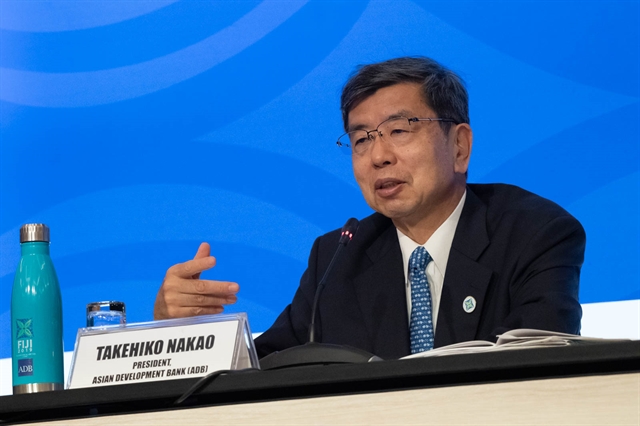 Economy
Economy

Climate and sustainable development are among key issues currently under discussion between high-level officials from the Asian Development Bank (ADB) and its member countries at the 52nd ADB Annual Meeting being held in Fiji on May 1-5.

|
| ADB President Takehiko Nakao at the press conference on May 2 in Fiji. — Photo courtesy of ADB |
By Mai Huong
NADI – Climate and sustainable development are among key issues currently under discussion between high-level officials from the Asian Development Bank (ADB) and its member countries at the 52nd ADB Annual Meeting being held in Fiji on May 1-5.
These issues are critical to the continued growth of the Asia Pacific region, especially in the context that Fiji is the first Pacific developing member country to host such an important event.
“Climate change is becoming more critical, including extreme drought and more frequent heatwaves,” says ADB President Takehiko Nakao at the press conference on May 2.
“It is a good moment to see challenges and opportunities for Pacific countries, how climate change affects these countries and how international communities including ADB can support these countries.”
Nakao said last year ADB adopted the Strategy 2030 with more concrete ideas, focusing on seven operational priorities including poverty reduction, gender equality, environment, urban issues, rural development and food safety, governance and regional cooperation and integration.
Under this strategy, ADB ensures that 75 per cent of its committed operations will be supporting climate change mitigation and adaption by 2030. Climate finance from ADB’s own resources will reach US$8 billion for the period 2019-30.
The bank is committed to prioritise support for the poorest and most vulnerable countries.
“We’re trying to go to the frontier countries,” ADB President said, noting as Asia is becoming more developed, ADB would apply differentiated country approaches to meet diverse needs of various groups of countries, including conflict-affected countries and small island developing states.
“We should pay attention to the specific needs of the country and allocate large amount of support to smaller countries.”
He said ADB would reduce lending to countries such as Brazil, Mexico and China and give more financing to poorer economies. Its support for these countries is now focused on climate change and environment.
ADB’s lending operations have grown, reaching close to $22 billion last year, up 55 per cent compared to $14 billion in 2013. Its response to climate change accelerated with the share of ADB operations supporting climate change adaption and mitigation in 2016-18 reaching 56 per cent, surpassing the 2020 target of 45 per cent.
Pacific Ministers representing 15 Pacific island members in the meeting with ADB President on the previous day also expressed their hopes that the bank would scale up grants and concessional financing for the smallest and most vulnerable members.
Responding to their concerns, ADB President said the bank would expand support to help the Pacific islands develop stronger resilience to global economic shocks, disasters and climate change. — VNS
ADB launches $5 billion healthy ocean action plan On May 2, the Asian Development Bank (ADB) launched the Action Plan for Healthy Oceans and Sustainable Blue Economies for the Asia and Pacific region at the 52nd ADB Annual Meeting in Fiji. The plan will expand financing and technical assistance for ocean health and marine economy projects to US$5 billion from 2019 to 2024, including co-financing from partners. It will help create inclusive livelihoods and business opportunities in sustainable tourism and fisheries; protect and restore coastal and marine ecosystems; reduce land-based sources of marine pollution; and improve sustainability in port and coastal infrastructure development. As part of the action plan, ADB will launch the Oceans Financing Initiative to create opportunities for the private sector to invest in bankable projects that will help improve ocean health. The initiative, being piloted in Southeast Asia in collaboration with the ASEAN Infrastructure Fund and the Republic of Korea, will provide technical assistance grants and funding from ADB and other donors through instruments such as credit risk guarantees and capital market “blue bonds”. The “blue economy”, which includes livelihoods and other economic benefits derived from oceans, is estimated at between $3 trillion to $6 trillion per year globally. Oceans contribute significantly to the gross domestic product of many developing countries – as much as 13 per cent in Indonesia and 19 per cent in Viet Nam. — VNS |




